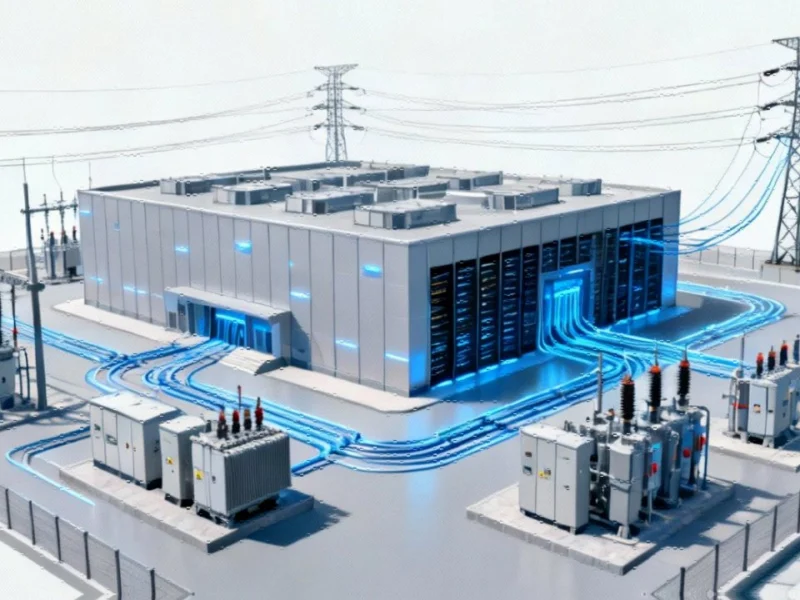Note: Featured image is for illustrative purposes only and does not represent any specific product, service, or entity mentioned in this article.
The Unseen Infrastructure Revolution
While much attention focuses on AI’s computational demands, a quieter revolution is unfolding in how data centers secure their most critical resource: electricity. Forward-thinking operators are increasingly bypassing traditional utility constraints by building and managing their own distribution infrastructure. This strategic shift represents more than just backup power—it’s becoming a fundamental competitive advantage in an industry where reliability directly translates to revenue.
The Grid Capacity Crunch
The explosive growth of artificial intelligence and cloud services has positioned data centers among the world’s fastest-growing electricity consumers. From hyperscale campuses to regional edge facilities, these digital factories are driving unprecedented demand that existing grid infrastructure struggles to accommodate. While policymakers debate generation and transmission solutions, the most immediate bottlenecks often occur at the distribution level—the final mile where power reaches its destination through substations, feeders, and switching systems.
Recent industry developments highlight how major corporations are preparing for increased AI integration, further straining power resources. Similarly, market trends show growing scrutiny of corporate infrastructure investments, making reliable power management both an operational and financial imperative.
Taking Control: The Private Distribution Advantage
Sophisticated operators are deploying advanced switchgear and real-time distribution management systems that provide precise control over electricity flow within their facilities. These private systems offer three critical benefits that public utilities cannot always guarantee:
- Enhanced Reliability: Isolating faults before they cascade through operations
- Deployment Speed: Bypassing utility interconnection queues that can delay projects by years
- Sustainability Integration: Seamlessly incorporating onsite generation and storage
As highlighted in this comprehensive analysis of private power grid implementation, the most successful deployments combine cutting-edge hardware with sophisticated management software.
Technology Enablers Making Private Grids Practical
Modern underground distribution switchgear has emerged as a particularly valuable solution, offering fault-isolation capabilities and reliable loop-switching performance in a compact footprint. These systems require significantly less maintenance than above-ground alternatives while providing superior protection against environmental factors.
The technological foundation for these systems continues to evolve, with recent technology improvements in system management interfaces making complex power distribution more manageable. Meanwhile, related innovations in security protocols ensure these critical systems remain protected from cyber threats.
Overcoming Implementation Barriers
Despite the clear advantages, many operators hesitate due to perceived constraints around costs, expertise, and regulatory compliance. However, these barriers are increasingly surmountable:
- Cost Uncertainty: Modular approaches allow phased investment rather than massive upfront capital
- Expertise Gaps: Specialized engineering firms now offer turnkey private distribution solutions
- Regulatory Complexity: Clearer frameworks are emerging as policymakers recognize the public grid benefits
Innovative monitoring solutions are also becoming more accessible, with related innovations in sensor technology offering new ways to track system performance. Additionally, industry developments in open-source monitoring tools provide cost-effective management options.
The Policy Landscape Evolution
State and federal regulators are beginning to recognize that private distribution innovation benefits the broader grid by reducing strain on public infrastructure. Forward-thinking policies are emerging that:
- Provide clear frameworks for permitting and interconnection
- Extend grid modernization tax credits to non-utility actors
- Incentivize utility-customer collaboration on shared reliability goals
This regulatory evolution acknowledges that data centers now play an undeniable role in our digital economy, and their power management approaches significantly impact overall grid stability.
Strategic Implications for the Industry
Data centers that master private power distribution gain more than just reliability—they achieve deployment agility that can accelerate time-to-market by months or even years. This capability becomes particularly valuable in secondary markets where utility infrastructure may be less developed. The operators who invest in these systems today are positioning themselves to capture the next wave of AI and edge computing demand that will test the limits of conventional power delivery.
The transition toward self-managed distribution represents a fundamental shift in how data centers approach their core infrastructure. Rather than viewing power as a utility service to be consumed, forward-looking operators are treating it as a strategic resource to be optimized—a perspective that may ultimately determine which companies thrive in the increasingly power-constrained digital economy.
This article aggregates information from publicly available sources. All trademarks and copyrights belong to their respective owners.



